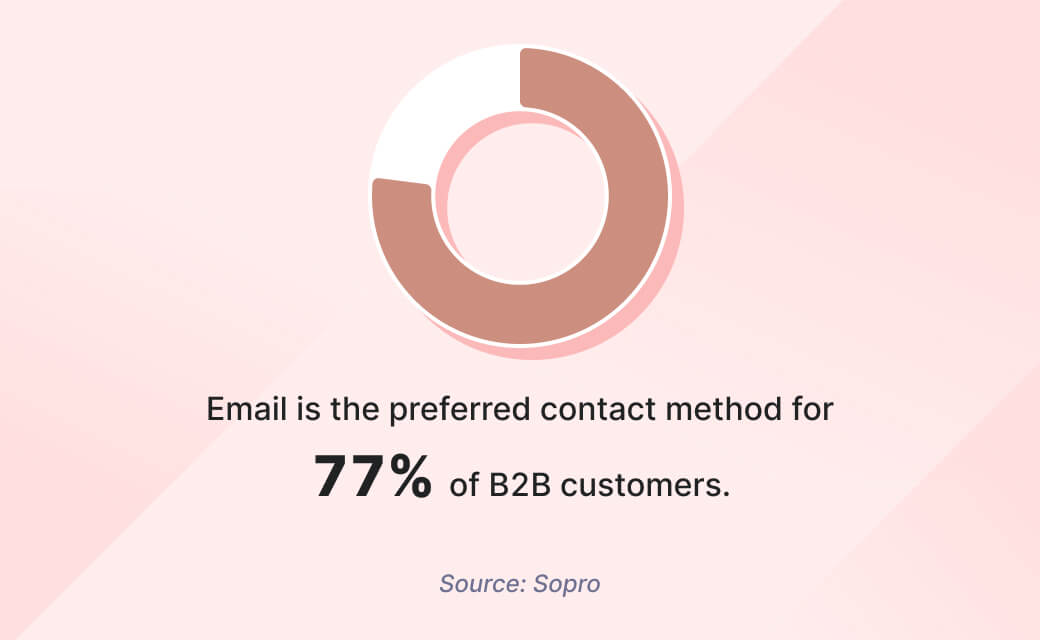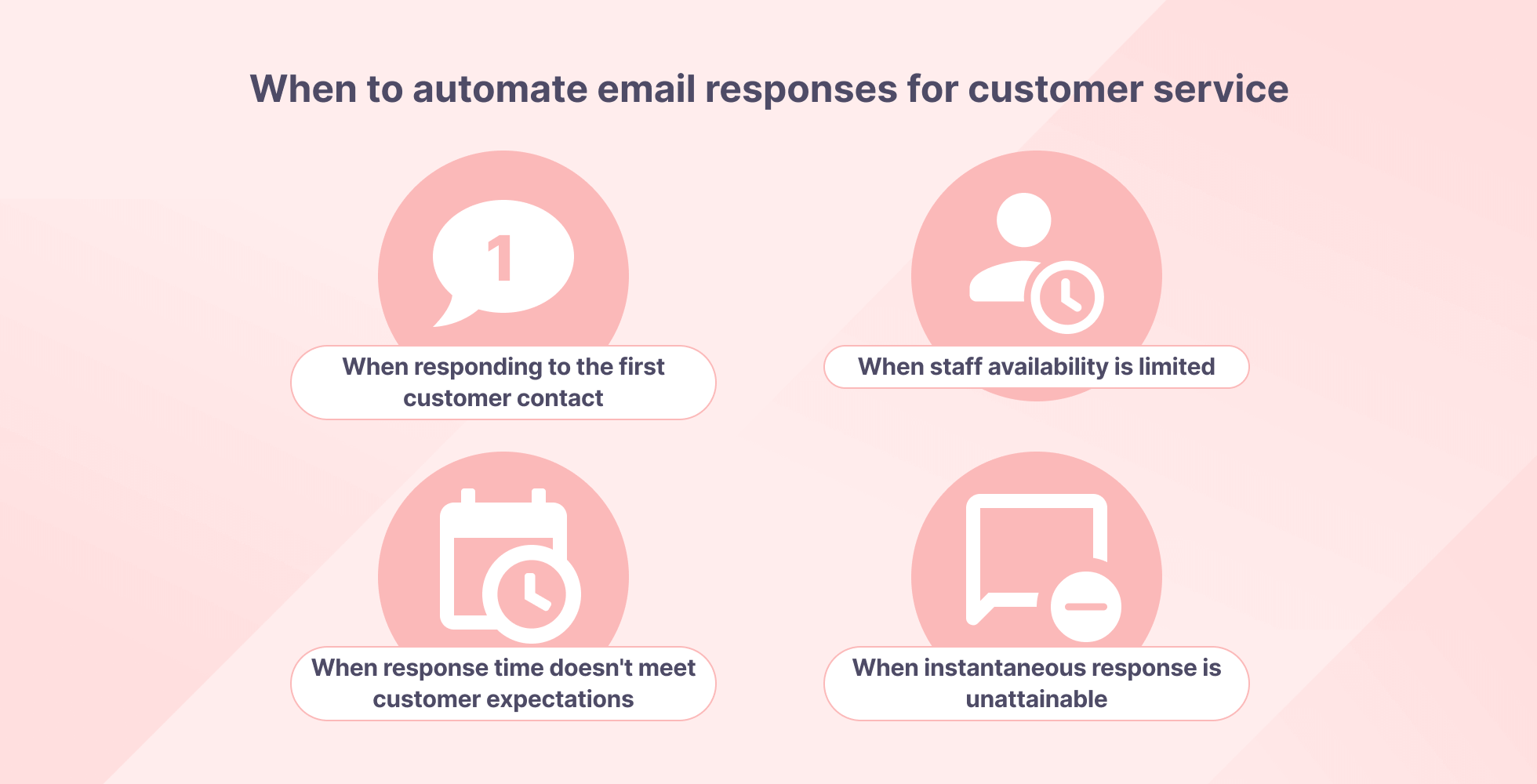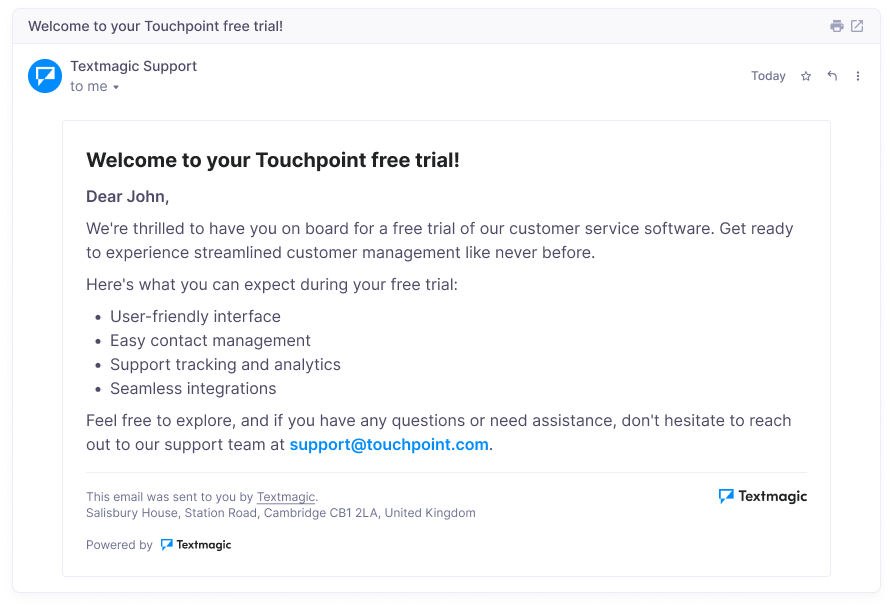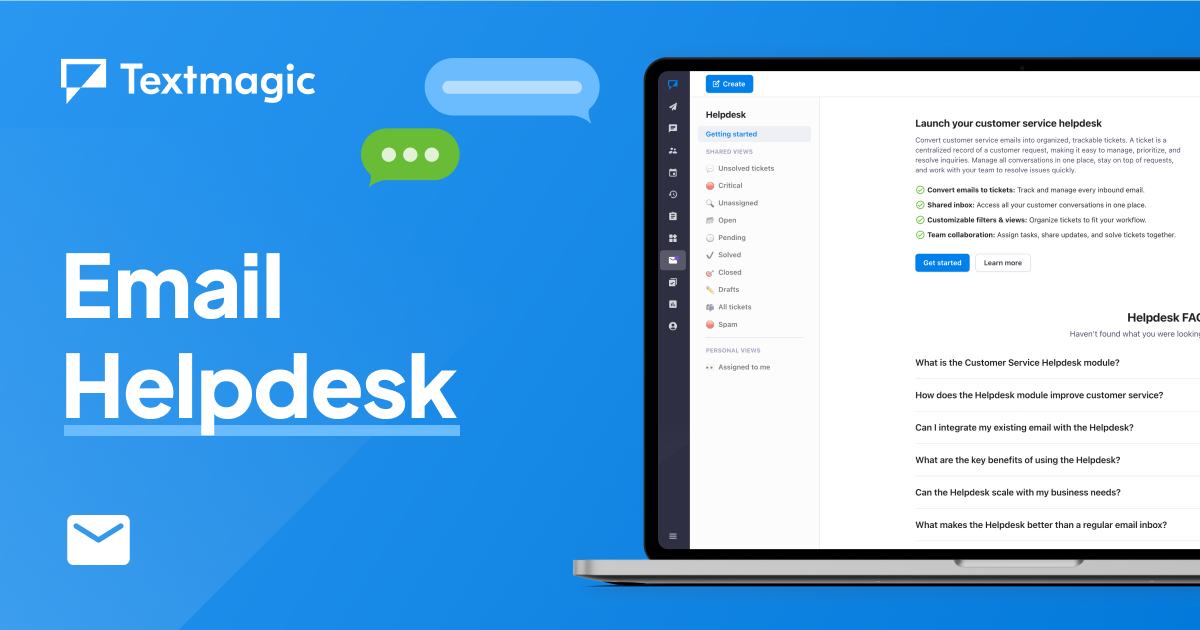
The quest to provide exceptional support while optimizing operational efficiency is a constant challenge for businesses. They must strike the right balance between resource allocation, fast response times, and personalization. A strategy that has emerged to address this challenge is the implementation of systems to automate email responses.
Email is the preferred contact method for 77% of B2B customers, making it twice as popular as any other communication channel. This statistic alone speaks volumes about the significance of email in today’s business interactions.

In the following sections, we’ll delve into the strategies and templates that can help businesses leverage automated email responses effectively. From acknowledging inquiries promptly to providing valuable information and solutions, we’ll explore how automation can lead to customer support that customers truly appreciate.
What is an automated email response?
Automated email responses consist of pre-programmed, software-generated replies tailored to specific types of incoming messages. These automatic replies confirm to the sender that their email has been successfully received. Once configured, these email responses activate whenever an incoming email meets predefined criteria.
Some companies opt for comprehensive automated emails in sales, such as cold emails and product pitches. Others prefer to use email automation in marketing, for customer list subscriptions or newsletters. Automated marketing emails are not responses per se, as they don’t normally respond to a certain trigger.
Businesses can also automate email responses to provide better customer service. The following sections emphasize the importance of automating email responses to enhance the support experience.
🙋♂️ Not ready for email automation? You can still communicate with customer more efficiently by incorporating our extensive collection of email templates for customer service that cover the most common scenarios.
When to automate email responses for support
Automated customer service proves valuable for businesses in diverse scenarios:

1. When responding to the first customer contact
An automated email response is a message you send just once. It should be activated when a customer initially contacts your team.
🚫 Don’t rely on email response automation for each subsequent response. If a customer does not respond to a thread following several days of inactivity, your team should assume that the customer is aware that you have received their email.
2. When staff availability is limited
It’s advisable to incorporate email follow-up automation when you can’t maintain nearly constant human staffing to ensure a quick response time.
🚫 Do not automate email responses when customer inquiries are complex, unique, or require a nuanced human touch. Automated responses may not adequately address these situations and can lead to customer frustration.
3. When response time doesn’t meet customer expectations
Use email response automation when the response timing varies from what customers typically expect. For example, an automated out-of-office email response can inform your customers about potential changes in the usual pattern of your responses, as well as any anticipated delays.
🚫 Avoid automation for urgent inquiries or escalations where immediate intervention is key to addressing the matter effectively.
4. When instantaneous response is unattainable
Businesses should use automation when they cannot achieve an almost instantaneous response time due to a high volume of inquiries. Automated emails provide customers with immediate reassurance, even when the response may take longer.
🚫 Avoid generating automated email response templates for customer service with ChatGPT. They may not be suitable for sensitive or personal matters, such as privacy concerns, legal issues, or delicate customer complaints.
Types of automated email responses for support
Here are some common types of email response automation in customer service, along with templates for each one.
1. Welcome emails
Automated welcome emails are designed to provide customers with a warm and informative greeting, typically expressing gratitude for their interaction with the company. This could be when customers sign up for a free trial or make their initial purchase.
They create a positive first impression, showing customers that the company values their engagement and aims to provide a helpful and pleasant experience.
Subject line: Welcome to your [customer service software] free trial!
Dear [Customer name],
We’re thrilled to have you on board for a free trial of our customer service software. Get ready to experience streamlined customer management like never before.
Here’s what you can expect during your free trial:
- User-friendly interface
- Easy contact management
- Support tracking and analytics
- Seamless integrations
Feel free to explore and, if you have any questions or need assistance, don’t hesitate to reach out to our support team at [support email or phone number].
Best regards,
[Your name]
[Your title]
[Your company name]

2. Frequently asked questions (FAQ) emails
An automated FAQ email is a pre-designed message sent to new customers, subscribers, or users as a part of their onboarding process.
FAQ welcome emails provide immediate answers to common questions, helping new customers proactively resolve potential issues or concerns right from the start.
Subject line: Welcome to [Your company name] – Your FAQs answered
Dear [Customer name],
We’re thrilled to have you on board for a free trial of our customer service software. Get ready to experience streamlined customer management like never before.
Here’s what you can expect during your free trial:
- User-friendly interface
- Easy contact management
- Support tracking and analytics
- Seamless integrations
Feel free to explore and, if you have any questions or need assistance, don’t hesitate to reach out to our support team at [support email or phone number].
Best regards,
[Your name]
[Your title]
[Your company name]
3. Inquiry emails
An inquiry email response for customer service automation is a pre-designed email reply generated by software in response to customer inquiries or requests.
Inquiry email responses ensure customers receive immediate acknowledgment, even when the support team may not be available 24/7.
Subject line: Your inquiry regarding [Product/service/topic]
Dear [Customer name],
We would like to assure you that we’ve received your inquiry. Our dedicated team is currently reviewing it.
Kindly allow us [mention estimated response time, e.g., 24-48 hours] to thoroughly address the issue. In the meantime, if you have any additional details or specific information to help us better comprehend your needs, please feel free to reply to this email.
Thank you for considering [Your company name] as your trusted provider of [Product/service/topic].
Best regards,
[Your name]
[Your position]
[Your company name]

4. Reminder/alert emails
Many companies depend on automated email notifications to send reminders and important alerts. For instance, they might use these emails to remind customers of upcoming appointments or to notify them of a change regarding their account.
These emails provide a positive customer experience by ensuring that customers are well-informed.
Subject line: Important account update – [Brief description]
Dear [Customer name],
We hope this message finds you well. We would like to let you know about an important update regarding your [Your company name] account.
Account update details:
- Description: [Brief explanation of the update]
- Effective date: [Effective date of the update]
- Action required: [Any specific actions the customer needs to take, if applicable]
If you have any questions or need further information, please contact our dedicated support team at [support email or phone number].
Thank you for choosing [Your company name] as your trusted partner.
Best regards,
[Your name]
[Your title]
[Your company name]
5. General confirmation receipt emails
General confirmation receipt emails are automated messages sent to customers or users to acknowledge and confirm a specific action or transaction. This automated email system serves as a formal record and provides essential details related to the action, such as purchase information, reservation details, or account updates.
Companies demonstrate their commitment to customer satisfaction by promptly confirming actions or transactions.
Subject line: Confirmation of your recent purchase
Dear [Customer name],
Thank you for choosing [Your company name] for your recent purchase.
Purchase confirmation details:
- Order number: [Order number]
- Date of purchase: [Date of purchase]
- Item(s) purchased: [List of items purchased]
Your transaction has been successfully processed.
- Estimated delivery date: [Estimated delivery date]
- Tracking number: [Tracking number]
- Carrier: [Shipping carrier]
Feel free to use the tracking number provided to monitor the status and location of your shipment.
Best regards,
[Your name]
[Your title]
[Your company name]
Six tips on how to automate email responses
Automation is a powerful ally in delivering efficient customer support. Here are some helpful suggestions on how to use automated email responses for improved customer interactions.
1. Acknowledge receipt of customer emails
This may sound obvious, but it’s essential to begin your automated email responses by promptly acknowledging the receipt of your customer’s email. This simple step assures the customer that their message has been successfully received and is in the process of being addressed. It sets their expectations and provides a sense of reassurance.
2. Communicate your team’s working hours
Transparency regarding your customer support team’s working hours is key to managing customer expectations. Automated email responses should include information about the hours your team is available to assist customers. This practice minimizes frustration by ensuring customers understand when they can reasonably expect assistance.
3. Offer alternative contact methods
Mention alternative ways for customers to contact you (live chat or phone support) in your automated email responses. This provides customers with flexibility in choosing their preferred communication method. It also ensures that customers with urgent matters or complex inquiries can reach out through channels that offer quicker resolutions.
4. Leverage customer details for personalization
Automated email responses often come across as lacking a personal touch, and most customers can distinguish between manually crafted and automated emails. It’s advisable to introduce a degree of personalization in your email communications, such as including names when appropriate, to enhance the connection with your customers.
5. Enable self-help troubleshooting
Support customers in resolving issues by guiding them toward self-help resources. In your automated email response, include links to FAQ pages, troubleshooting guides, or knowledge base articles that can assist them in addressing common problems independently. This empowers customers and minimizes the recurrence of similar inquiries.
6. Suggest providing comprehensive information
To facilitate a faster and more accurate resolution, include tips in your automated response on the additional information customers can include when describing their issues. They could be about specifying order numbers, providing error messages, or attaching relevant screenshots.
Turn messy inboxes into organized workflows
Bring structure to your support inbox in just a few clicks. No more missed messages, slow replies, or scattered threads.

Simplify support with Textmagic’s Email Helpdesk
Our Email Helpdesk helps you stay on top of every inquiry by turning messy inboxes into trackable, manageable tickets. It’s built for small businesses that want to keep customer conversations professional, timely, and efficient, without the complexity of traditional support systems. Assign messages to teammates, set priorities, and track every response, so nothing slips through the cracks.
- Stay on top of every message with centralized communication and shared inboxes
- Speed up response times by assigning tickets and setting priorities
- Keep your team in sync with internal notes and real-time collaboration tools
- Make smarter decisions using built-in reports and performance tracking
- Scale with ease as your customer base and support needs grow
Whether you’re handling sales inquiries, support requests, or follow-ups, Helpdesk keeps your communication organized and your customers happy.
Ready to send out automated email responses?
Automation doesn’t mean losing the human touch; it means delivering faster, more consistent support while freeing up your team for the conversations that matter most. Whether handling first-time inquiries, managing off-hours communication, or keeping customers updated, automated email responses can streamline your workflow and improve the overall experience.
Textmagic’s Email Helpdesk lets you set up timely auto-replies, manage conversations in a shared inbox, and easily track and resolve every inquiry. Try it today and see how automation can make customer communication easier, smarter, and more effective.
Frequently Asked Questions (FAQs)
Yes. You can embed feedback links or short surveys in follow-up emails.
Textmagic’s Email Helpdesk allows you to do that easily.
Transactional updates (like order confirmations or delivery notices), appointment reminders, billing alerts, and FAQ responses are perfect for automation.
These messages follow predictable patterns and don’t typically require human judgment, making them ideal for improving service speed.
Include the customer’s name, a thank-you note, estimated response time, and links to helpful resources like FAQs or account portals.
Use conversational language and personalize responses with the customer’s name or details related to their request. Keep the tone friendly and natural.
Empathy should be a part of your messaging. A simple “We understand this can be frustrating” can go a long way toward softening automated replies.
Related articles
16 Key metrics for measuring and improving customer engagement
Customer engagement metrics assess the emotional con...
Texting your way to success: Conversational commerce SMS
In 2021, the global conversational commerce market w...
Steal these SMS reminder ideas to avoid losing sales
Every business needs to send reminders to customers ...
Mastering customer feedback: Top 20+ tools to explore in 2025
Listening to the customer has evolved into the corne...
PRI vs. SIP Trunking: What is the difference and which one to use?
At their core, both PRI and SIP trunking are designe...




